 |
 |
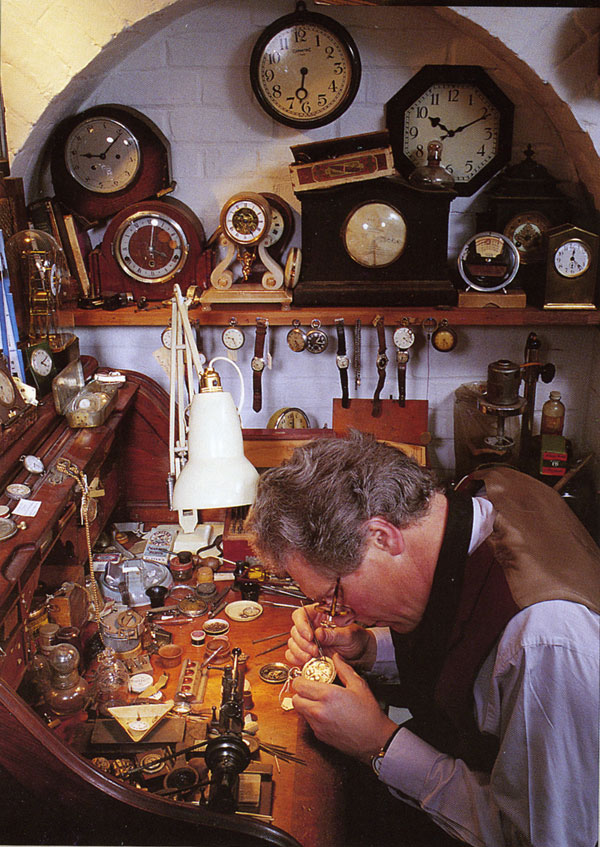
LOCAL MAKERS 1700-1799
Thomas Atkinson |
By the 18th century clockmakers were becoming more numerous, and every town would have a clock maker or a clock seller. The most famous in Suffolk were the Moore family of Ipswich, Thomas Moore being the best known of the family.
Lantern clocks were first made in Suffolk in the second half of the 17th century, but they continued to be made in Suffolk into the middle of the 18th century as well. Older wheel balance lantern clocks and short bob clocks also got converted to long pendulum control in this period.
The period from 1720 to 1760 has been called the Golden Age of Clockmaking in England. During these years the production of high class Long Case clocks in Suffolk was at its peak.
After 1760 there came a trend for painted dials, and by 1780 there came batch production of parts and movements, allowing clock assemblers to gradually replace clock makers.
All of the Watch and Clockmakers on this page are listed alphabetically on the left, but are described below roughly in date order. Thus the earliest makers will thus appear first.
Click here if you wish to look back to The local 17th Century Makers |
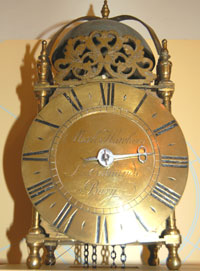 |
Mark Hawkins senior, Bury St Edmunds, (b1674-d1750) Mark Hawkins the first was born about 1674, probably at Newmarket. He may have worked at Bury as early as 1694, but we know for certain he had moved to work in Bury St. Edmunds when he married there in 1701, and that he remained there till his death in 1750. Richard Rayment and Mark Hawkins worked in Bury as clock making rivals for virtually their entire lives, certainly for forty years. Hawkins was the elder by ten years or so. Rayment outlived him by only four years. Mark Hawkins had five children. There was Mark in 1702 who died in infancy, William in 1703, John in 1705 who died in infancy, another Mark in 1707 and George in 1711. Mark Hawkins was followed into his business at the corner of Whiting Street and Churchgate Street by his son William. His namesake son, Mark Junior, seems to have set up on his own. Because there were two Mark Hawkins it is difficult to know whether a clock bearing that name is by the father or the son. George became an Attorney, avoiding the horology business. In 1704, Mark Hawkins replaced the church clock at St James's church, in Bury. The agreement gave him the old clock for his own use, together with the sum of 21.1.6d, for a new clock, tables, (?) and chimes. Haggar and Miller reported that this clock was subsequently replaced, but is in a private collection. Other clocks attributed to Mark Senior include a single longcase and a lantern clock. The 1979 Catalogue of the Gershom Parkington Collection included the Longcase clock and Lantern clock of Mark senior, and his lantern clock can be seen on display in Moyse's Hall Museum in 2007. This Lantern Clock is signed "Mark Hawkins St Edmunds Bury." By clicking on the clock you will see an enlarged picture. Note that there is no minute hand, as was usual at this time. Each hour on the dial was divided into the four quarters, and the time is estimated to the quarter hour by reading off the position between the hours. Mark Hawkins died at 76 years old on 11th March 1749, but we would reckon it to be in 1750. (Until 1752 the year was not reckoned to begin until March 25th.) Mary, his wife, died on 29th March 1752. They are buried at Nowton.
|
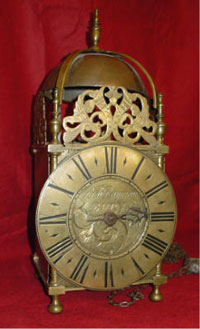 |
Richard Rayment, Bury St Edmunds, b1686-d1754 Richard Rayment is recorded by Haggar and Miller as one of Suffolk's most important makers. An advertisement of 1748 records his premises as "in the Cook Row, Bury St Edmunds."
The first illustration here is of a good anchor escapement lantern clock, with an engraved dial with foliate centre and signed "Rich:d.Rayment Bury". This description and the first clock shown here comes from the website of Clock dealer, Richard Harris at http://www.rchclocks.fsnet.co.uk/LCA.html This clock was sold by him recently. Most of this information quotes directly from Haggar and Miller.
|
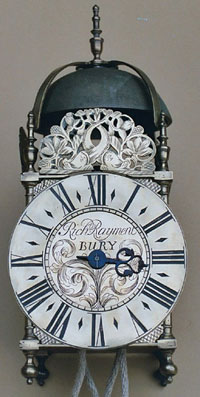 |
The second illustration comes from the website of clock dealer Brian Loomes of Harrogate, at www.brianloomes.com. The pattern of frets used by Richard Rayment was often the one incorporating crossed dolphins, seen here.
Richard Rayment of Bury St.Edmunds was born around 1686, and died in 1754. His eldest son, Richard, became an attorney-at law. Richard Rayment himself was not only a fine craftsman; he was also very successful in business. As a freeholder in Bury he voted in the Suffolk county poll of 1727, and in 1734 he served as churchwarden at St.Mary's church.
Richard Rayment died in 1754 and was buried at St.Mary's Church in Bury on 17th May, his memorial reads "Mr Richard Rayment aged 65."
|
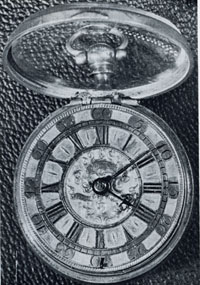 1727/29 |
The 1979 Catalogue of the Gershom Parkington Collection included two Longcase clocks by Richard Rayment, (c1730 and c1740), as well as a watch, (c1729) and a bracket clock, (c1740). The silver pair-cased verge watch is signed "Rich: Rayment, St. Edms. Bury", and is illustrated here. This illustration comes from "Suffolk Clocks and Clockmakers". A view inside the case can be seen by clicking on the illustration. The oak 30 hour Long Case clock has a lantern type movement, with both hour and minute hands. This is signed on a curved plate "Richd Rayment, Bury".
|
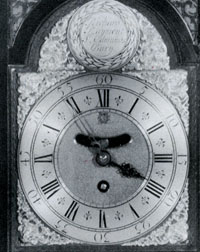 1740 |
The Richard Rayment bracket clock illustrated here is from the Gershom Parkington catalogue of 1979. It is signed, "Richard Rayment St Edmunds Bury." It has an 8 day verge escapement with repeating action on two bells, half seconds pendulum, and an ebonised case. It is dated to about 1740. Another example of his work is in the Bridewell Museum, Norwich. Haggar and Miller's Supplement to Suffolk Clockmakers included a report that a turret clock at All Saints Church, Great Thurlow, was made by Richard Rayment of Bury St Edmunds, in 1734. There are at least thirteen surviving Rayment clocks, more than most Suffolk makers. The book 'Suffolk Clocks & Clockmakers' by Arthur Haggar and Leonard Miller, records several clocks by Richard Rayment including a number of longcases, bracket clocks, at least one watch and three lantern clocks. Others are known to exist, having passed through the hands of dealers.
|
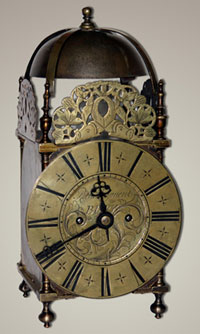 1730 - modified |
This text comes from www.londonclocks.co.uk:
"Lantern Clock by Richard Rayment BURY ST EDMUNDS, SUFFOLK |
 |
This clock is one of Richard Rayment's long case clocks. The sale details come from the website of Reeman-Dansie: " This is an 18th century longcase clock with thirty hour movement, eleven inch brass dial with pierced face mask and foliate spandrels, single pierced hand and silvered chapter ring, signed - Richard Rayment, Bury St. Edmunds, in an oak case with full length door, hood with turned columns, pierced scroll pediment and three ball and spire finials, 213cm overall height (pendulum and weight present). The estimated sale price was 300- 500, probably lower than expected as the case does not seem to be wholly original.
|
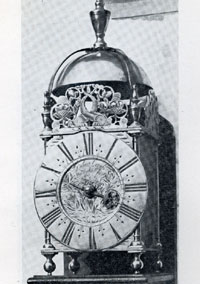 |
Robert Leach of Stradishall, died 1725 Little information is available about Robert Leach. However, his second marriage to Elizabeth Wright was recorded at Stradishall on 17th February 1712. They had a son called Robert, who was baptised on 8th July, 1712 at Stradishall. Robert Leach, senior, was buried on 16th February, 1725. Two Lantern clocks are known by Robert Leach. One has the favoured dolphin patterned fretworks of Suffolk makers, and is illustrated here. A modern movement has been fitted to this clock, and the finial was presumed to be a replacement by Haggar and Miller, as they considered it to be too large. Nevertheless, there is some original fine work visible on the clock's dial, and in the fret work.
William Rayment, Stowmarket, married 1706, died c1760 A clockmaker named William Rayment worked at Stowmarket in Suffolk from about 1706, when he married, till his death about 1760. It is not known just how he was connected to Richard Rayment, or even if he was related. It is suggested that he might have been Richard's brother, as he was the right age, but Haggar and Miller say they could find no proof one way or the other. Married in Combs, he lived in Onehouse, where he died. Lantern clocks are known by him, one sold in 1970 at Sotheby's was signed "Wm Rayment, Stow Markett". An 8 day long Case clock is also reported.
|
 |
William Hawkins, Bury, 1740, (b1703-d1775) This text comes from www.londonclocks.co.uk:
"Lantern Clock by William Hawkins
The clock having 5 1/2" square frame, 6 1/2" diameter chapter ring of 1 1/2" width and finely engraved 6" high dial plate. The clock stands 15" high to top of bell finial. William was the second son of Mark Hawkins senior, and older brother to Mark junior. It is thought that he succeeded to his father's business in about 1740. This was located at the corner of Whiting Street and Churchgate Street. Advertisements in the Ipswich Journal show that he made silver watches. On 14th December 1742, he advertised, "Lost, silver watch, the Maker's name 'William Hawkings, Bury St Edmunds.'" In 1744 another watch was stolen, numbered 1738. In 1747 the IJ of 7th November reported that he was bankrupt, and that "A messuage or Tenement in the Whiting Street" was to be disposed of. We do not know what happened after that, but Haggar and Miller note that he was a ratepayer in Cook Row in 1757, 1768 and 1770. The 1979 Catalogue of the Gershom Parkington Collection included a tall lacquer cased Longcase by Mark Hawkins' second son William, (c1740-45). The collection also includes a watch movement by William Hawkins. It has no case, but an enamel dial with a verge escapement, from c1730. A number of Long Case clocks survive made by William, most notably a nine feet tall black lacquer case, showing the phases of the moon. This is even taller than the Gershom Parkington example,and is dated to about 1730. William died in 1775 and was buried at Nowton on 21st March.
|
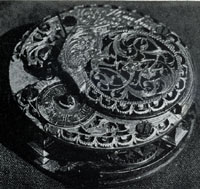 |
Mark Hawkins junior, Bury St Edmunds, 1740 (b1707-d1767) The 1979 Catalogue of the Gershom Parkington Collection included two Long Case clocks by Mark Hawkins' third son, Mark junior (both c1740). From advertisements in the Ipswich Journal in 1754 and 1775, Haggar and Miller identified that Mark junior made watches. They illustrated an example of a watch by Mark Hawkins, which is reproduced here. It is described as a Verge Watch movement of rather unusually decorative design, with lace like scalloped edge to the balance cock, and repeated on the main plate. This movement is signed, "Mark Hawkins, St Edmunds Bury." In 1750, Bilby Dorling was apprenticed to Mark Hawkins of Bury St Edmunds, for a fee of 10. Dorling later set himself up in his own watchmaking business in Bury. (See below). Another advertisement on 30th September, 1752, puts him, "at Mark Hawkins' at the Crown and Dial in the Cook-Row, the corner of Hatter Street, St Edmunds Bury, Suffolk." On 30th March, 1754, he was advertising, "Enquire of Mark Hawkins, Clock and Watchmaker, removed from the Seven Stars and Dial over to the Crown and Dial at the corner of the Hatter-Street in the Cook Row in Bury St Edmunds. NB He will attend his shop at Newmarket from the 8th April next 'till the Meeting is over." Presumably he attended at Newmarket during Race Meetings. On 24th September 1754, his advert noted, "NB I am the only Mark Hawkins in Bury, and give the best prices for old Watches, Gold, Silver, Brass and Lead." Mark was buried at St James's in Bury on 3rd May 1767, having died on 28th April. Many 8-Day Long Case clocks survive of his, in walnut, lacquer and mahogany, all with arched dials. Early ones are signed "Mark Hawkins jun" to distinguish them from his father's work. Haggar and Miller note that the "w" in Hawkins can look very much like an "n".
|
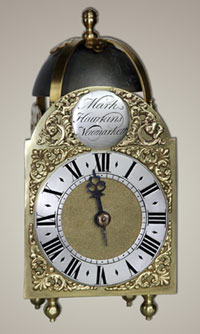 Newmarket |
Mark junior also seems to have marked his clocks as 'Newmarkett', when sold from his shop there. This text and picture comes from www.londonclocks.co.uk:
"Miniature Lantern Timepiece by Mark Hawkins
The clock having 3" square frame and 5 3/4" high by 4 1/4" wide break-arch dial. The clock stands 8 1/2" high to top of bell finial.
G Tew, Bury St Edmunds, early C18 Tew is known only from a Book by Brian Loomes, who reported an early 18th century lantern clock by G Tew of Bury. Haggar and Miller included Tew in their Supplement because he may have been related to Thomas Tue, (1613-1710), who is known to have made Lantern Clocks in Kings Lynn.
Thomas Gardiner, Sudbury, c1740, (b1696-d1762)
|
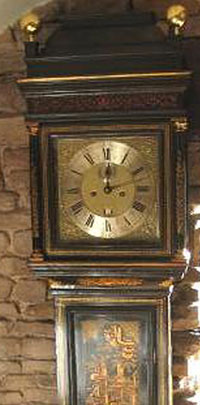 |
This clock appeared on the website of www.antique-clock.co.uk, at The Chimes of Whalley Bridge, in August, 2015. "Description Circa 1740 laqured Longcase clock By Thomas Gardiner Of Sudbury (Suffolk). Stunning Square Brass Dial, (rare to laqured case Clocks) Eight day Movement, Original Brass Cased weights, Lovely Proportions with Original Tea-caddy top to hood. and Original Hood Glass and Side Inspection windows. Price 12950.00 " This clock was not noted by Haggar and Miller. |
 |
Thomas Gardiner was recorded as a bellfounder at Sudbury, according to Haggar and Miller. His son Thomas was admitted as a Freeman of the Borough of Sudbury and it is believed that his father must also have been a Freeman, but no record exists of this. H & M note a 30-hour long case attributed to him, with a brass dial of two-handed pattern. |
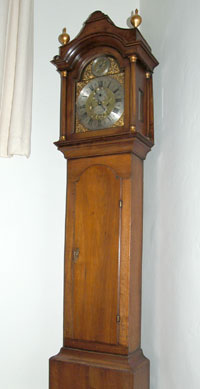 |
Giffin Rayment, Bury St Edmunds, 1754, (b1722-d1769) Giffin Rayment, who was born in 1722, was baptised in St Mary's church on 9th November of that year. His father was the well respected Clockmaker, Richard Rayment. Giffin seems to have had two wives, as three of his children are recorded at their Baptism at St Mary's as having a mother named Ellenor. Two more children were recorded, at least one with a mother named Esther Rayment. Giffin went on to succeed his father in 1754, when he inherited his late father's tools, equipment and shop premises. Giffin was Richard Rayment's second son, and he inherited the business because his older brother, Richard junior, had become a solicitor. Giffin is occasionally recorded as Griffin, but Giffin appears to be his name, and this version is used by Haggar and Miller. Giffin's career was short lived, surviving his father for only fifteen years. He died in 1769 aged only forty seven. Haggar and Miller record an advertisement in the Ipswich Journal for 8th December as follows: "An exceeding good Turret Clock, as good as new, for sale by Giffin Rayment, Clock and Watchmaker, Upper End of the Cook-Row, Bury St Edmunds." Since about 1792 Cook Row has been called Abbeygate Street. |
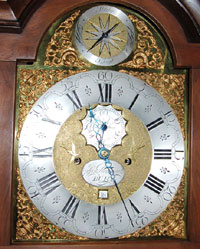 |
The fine 8 day longcase clock shown here by Giffin Rayment is to be found today in a private house in Guildhall Street, in Bury, located only a few yards from where it was built. The case is mainly built of walnut. It was supplied by Ernest Webb, jewellers of Abbeygate Street, in 1997. The movement was restored by M Guiver of Mildenhall, and the case by S Garland of Lavenham, who also installed a new base. |
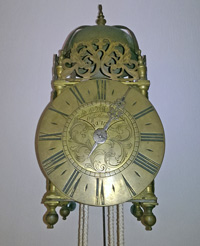 |
Haggar and Miller reported that no lantern clocks seem to be known by Giffin, probably because by the late 1750s the demand for them had largely passed away in favour of longcase clocks. However, in December 2017, I received emails from Marc Honcoop containing pictures of a clock which he owns. "I live in the Nederlands. I have a Lantern clock of Giffin Rayment. This is the only one he made.....The clock is all original with no signs of restoration. The clock was bought about 40 years ago for fl.15,000 gulden. (Equivalent today to 7600.) That was a lot off money for those years. I don't know the date the clock was made. Possibly he made the clock with his father about 1730-1740, but I think the clock is younger at about 1760." An Act of Parliament clock is also recorded from Giffin, with a tavern scene painted on the trunk door. Giffin Rayment died in January 1769, and, like his father, he was buried at St Mary's church on January 24th, according to Edward Ashton. His widow Esther was granted Administration as he had not yet made a will, being only 47 years old.
T Rayment, Bury St Edmunds, before 1763 This maker is known only from an advertisement in the Ipswich Journal for 17th September, 1763. "Lost, a small silver watch, the maker's name, T RAYMENT, Bury St Edmunds." Thomas Rayment was the son of Richard Rayment, but there is apparently no other evidence that he was a watchmaker.
Thomas Atkinson, Bury St Edmunds, early C18 A Thomas Atkinson married Elizabeth Crask, widow, on 26th July at St Mary's Church in Bury. The bridegroom's residence was given as Ely, but it is not known if this man was our clockmaker. Haggar and Miller recorded a Lantern clock made by Thomas Atkinson of Bury St Edmunds, dated to the first half of the 18th century. It had an 8 day spring movement, but was obviously converted from a weight driven movement.
|
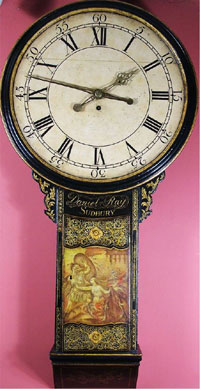 |
Daniel Ray, Sudbury, (b1700-d1772) This advertisement appeared on the website of Finchingfield Antiques in September, 2015: "A good 18th century Tavern Clock by Daniel Ray of Sudbury 1700 - 1772. The movement serviced and case restored.
The 29" white painted wooden dial (including bezel) with inner Roman numerals and outer Arabic numbers, with very fine pierced gilt brass hands. Both the minute and hour hand being counter balanced and being of a very rare style - the hour hand mimicking that of a longcase. |
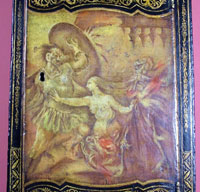 |
The eared trunk signed DANIEL RAY, SUDBURY, the trunk door having a reverse arch top, to conform with the dial, and having a painted scene after HOGARTH entitled "Satan, sin and death", sandwiched between intricate rococo and rose designs. The moulded base with chisel foot decorated with gilt floral tracery. The sides with a Griffin & Claw design framed with gilt latticework. The original Tavern movement with tapered plates, & 5-wheel train, accompanied by original weight, pendulum & key, runs for 9 days. The movement has been serviced in our workshop and is guaranteed for 2 years. What's very rare with this clock is that we have very good provenance for it..probably from day one! As can be seen in "The East Anglian Miscellany". The clock first hung in KENTWELL HALL. The image on the door being a copy of Hogarths unfinished oil of "Satan, Sin and Death", which is an illustration to John Milton's poem "Paradise lost". The then owners of Kentwell Hall, no doubt, intended the moral message to be directed at the staff! (Note - Hogarth's original painting is dated to 1735 to 1740, and is owned by the Tate Gallery.) In the late 19th century, the clock was gifted to The British School, in Mill Lane, Sudbury - and more recently was given to the Sudbury museum. Mention is also made in the article of the maker, Daniel Ray, whose tombstone may be seen in "St.Gregorys" Churchyard, close to the west door, having died May 23rd 1772 aged 72 years.
(stock no:661) Daniel Ray was the father of William Ray, who was also a clockmaker of Sudbury. |
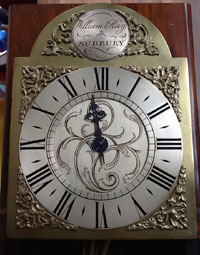 |
William Ray, Sudbury, 1750/1760, (b1734-d1808) William Ray came from a clockmaking family at Sudbury. His father was Daniel Ray (the second) and his grandfather was Daniel Ray the first. Grandfather had been a locksmith, and father was an "automatarius" and a clockmaker. One of his three sons was also called Daniel, who was a clockmaker in London as well as being a Freeman of Sudbury. The eldest son, William Redmore Ray, took over the family business in Sudbury. William Ray's shop was in the centre of Market Hill, next to the Moot Hall, remaining the family premises until demolition in 1840. Two 8 day long-case clocks are recorded in Haggar and Miller, with brass arched dials, one cased in oak, the other in walnut.
The first clock shown here is a 30 hour striking wall clock with an 8 by 11 inch dial, dated about 1750/60. It is in a private collection in London, the picture being kindly supplied by Mr PS. Today, it is normally enclosed by a modern case, which has been removed for this picture.
|
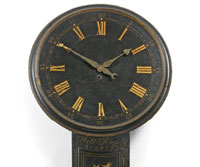 |
This second clock was sold at Bonham's Auction at the Athenaeum, Bury St Edmunds, in December, 2010. The auction estimate was 5,000 to 7,000. The catalogue description read: " An George III black lacquered weight driven tavern clock - William Ray, Sudbury - the black lacquered case with a 29.5 inch circular dial with gilt Roman hours and outer Arabic seconds dial, the rectangular case inscribed 'Willm Ray, Sudbury' and decorated with a chinoiserie scene with two figures before a house, the tapered base with foliage, with pendulum, key, winder and weight, 133cm high or 52" high "
Please click on the thumbnail for a view of the whole clock. |
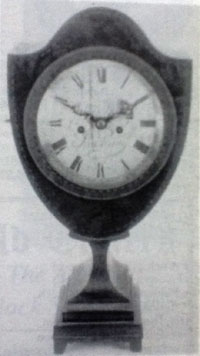 |
This superb mantel clock was believed sold at Christies in 1995 or 1996. Unfortunately this illustration does not do it justice. Christie's description was as follows: "A mahogany and chequer strung mantel clock, the 7in (18cm) silvered dial inscribed Willm. Ray, Sudbury, twin train fusee movement with anchor escapement, c1790, 20in (51cm) high. 1,500-2,000" (There was a William Ray recorded as a watch and clockmaker at 2, Brentgovel Street, Bury St Edmunds, in Directories from 1830 to 1884. He is dealt with in the section on 19th century makers, and Haggar and Millar thought that his family does not seem to be related to the Rays of Sudbury.)
However, in 2015 I was contacted by a descendent who had researched the family history. "William Ray and David Ray's eldest sister Sarah was my 4x Great Grandmother, hence we've been following the family sidelines forward." William Rowning, Brandon, 1737-d1757 William Rowning, of Brandon ferry was married at Chippenham to Mary Baily of Hockwold on 4th December, 1717. Hockwold was spelled 'Heckwell'. In 1737 the London Gazette for 11th January, 1737 announced his bankruptcy thus: "William Rowning, Inn holder and clockmaker, late of Brandon, Suffolk, insolvent." The Ipswich Journal for 16th July 1753 contained a 'lost watch' advertisement as follows: Lost Watch.....to be taken to William Rowning at the sign of the Bell in Brandon." He died in 1757 Several Long Case clocks are known to have been made by him. These are both 30 hour and 8 day, often in marquetry cases. An example sold at Sotheby's in 1972 had a walnut marquetry case, and a sweep second hand, a very uncommon feature in Suffolk at this time.
James Thatcher, Bury St Edmunds, 1737, d1748 The London Gazette recorded "James Thatcher, clockmaker of Bury St Edmunds, insolvent," on 9th July, 1737. He was buried at St James's Church, Bury, on 4th December, 1748. He leaves a Long Case clock with an arched dial, 8 day movement, signed on the boss in the arch.
|
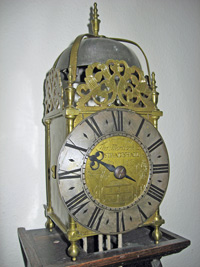 Stradishall |
Thomas Mortlock of Stradishall, 1744 This man may be the Thomas Mortlock who married Mary Flack at Stradishall on 4th August, 1745. Neither is it known if he had any connection with the Thomas Mortlock at Clare. He appeared in the Ipswich Journal for 15th September 1744, advertising as follows, "Stolen on Tuesday 11th instant from Mr Thomas Mortlock of Stradishall in Suffolk, two silver watches, the maker's name of one Wm. Hawkins, St Edmundsbury, the other a Ballance and chain watch." He is also known for an oak 30-hour Long Case clock, 11 inch brass dial, with an hour hand only, signed, "Thos. Mortlock, Stradishall."
|
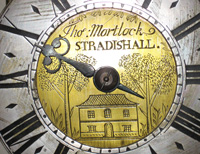 Thomas Mortlock of Stradishall |
In December 2017 I received a telephone call from Barry Dowsett, telling me of a Lantern Clock by Thomas Mortlock of Stradishall, which he bought in Salisbury. The face included an engraving of a large house, possibly representing the home of the original purchaser of the clock. This is the clock illustrated here, together with a close up view of the face
of Thomas Mortlock's lantern clock with the engraving of the mystery house. Mr Dowsett is keen to know the identity of the original owner and the location of this house, so if anyone has any ideas, please contact me and I will pass it on to him.
George Lumley, Bury St Edmunds, 1745, (b1723-d1784) George Lumley crops up in the lives of other Bury Watchmakers. He was mentioned in Richard Rayment's will, and he was a witness to the will of William Hawkins. There is a George Lumley in the Baptism Register of Little Welnetham for 18th April, 1723, son of George and Margaret Lumley. A George Lumley, described as the son of George Lumley, Watchmaker, of St Sepulchre, London, was apprenticed on 1st August, 1737 to James Lloyd for 7 years. He was admitted a Freeman of the Worshipful Company of Clockmakers on 8th October 1745. It is unclear whether these entries all refer to our George Lumley. According to information received from the modern day jeweller's Thurlow Champness, in 1745 George Lumley Freeman of the clockmakers company carried out his business from the premises in Cook Row, today known as 14 Abbeygate Street, Bury St Edmunds. George was occupying one of Richard Rayment's tenements in 1754. In 1775 he was respectable enough to be a witness to William Hawkin's will. He advertised on 12th October 1765, that a giant ox was being exhibited at his shop. Advertisements in the Ipswich Journal for 6th May 1780, and 28th June 1800, refer to lost watches, made by George Lumley. The Gershom Parkington collection has one watch by George Lumley of Bury St Edmunds, and a second watch may be by him, or by his widow, Mary. One is from 1780, and the second some five years later. The second watch from 1785 has letters instead of numbers on the dial. These read RICHARD PICKAN, possibly the name of the purchaser. George Lumley's widow, Mary, carried on the business after his death, and this watch is believed to have been sold by her, as George was dead by 1785. George Lumley died at age 62, and was buried on 14th September, 1784, at St James's Church in Bury.
|
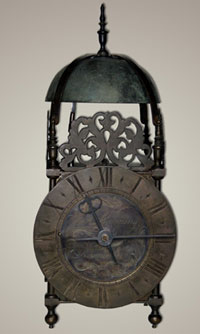 Newmarket |
John Rowning, Newmarket, 1750, (d1771) This text comes from www.londonclocks.co.uk:
"Lantern Clock by John Rowning
The clock keeps excellent time, with passing strike on the original lantern bell. Haggar and Miller state that John Rowning married Elizabeth Tuting at Wooditton on 20th November, 1745. H&M knew of only one long case clock marked 'Rowning Newmarket'. They had a son George in 1751 and he seems to have succeeded his father in the business when John Rowning died in 1771.
Edmund Smith, Bury St Edmunds, 1753-1779 Edmund Smith announced his arrival in Bury St Edmunds by advertisisng in the Ipswich Journal for 31st March 1753, repeating his notice two weeks later: "EDMUND SMITH, Watch and Clockmaker, from LONDON, has taken a shop opposite the Market Cross in Bury St Edmunds, where he makes and mends all sorts of gold and silver, Repeating and other watches, also Chime clocks, both weight and spring, Church and turret clocks, and all branches of the said business." Smith died in 1779, and was buried at St James's church on 10th October. A verge watch movement has been recorded by him, signed, "Edmund Smith, Bury from London, 1607".
Thomas Watts, at Hadleigh, bc1712-1765, and at Bury St Edmunds, 1765-d1768 Thomas Watts was believed to be the cousin of Thomas Watts (2) of Lavenham, where there had been a number of Clockmaking Watts. Thomas was probably the child recorded as baptised by Hadleigh Independents (Congrgationalist), on March 29th, 1712. He married Mary Dansie in Sudbury on 29th December, 1740. He made a new clock, together with chimes, for St Mary's church in Hadleigh, in 1750. These chimes played a different song-tune every day of the week, with a psalm on Sundays. Thomas Watts moved to Bury late in 1765, and announced the fact in the Ipswich Journal for 8th February, 1766: "Thomas Watts, Clock and Watchmaker, is removed from Hadleigh to the Cook-row in Bury St Edmunds. The business in Hadleigh will be continued, as he has employed a watchmaker from London." A further advertisement in the IJ for 10th October, 1767, informed local people that: "Thomas Watts, Watch-Maker and Goldsmith, at the Dial and Strikingboy in Cook-Row, Bury St Edmunds, has lately returned from London with a new assortment of Goods in Jewellry, etc. He makes, mends and sells all sorts of Repeating, Horizontal and plain watches". His wife, Mary, died in 1768, and Thomas died a few months later in October. He was buried on the 18th October, and like Mary, he was laid to rest in Hadleigh. A Lantern Clock exists, signed, "Thos Watts, Hadley." Several Long Case clocks are recorded by him.
Thomas Mortlock of Clare, 1768- d1788 A Thomas Mortlock was married in Clare Church on 17th July, 1768. He left a dark blue lacquered 8 day Long Case clock with a pagoda top. Well decorated with ball and spire finials, it has a calendar aperture and a silver second hand. It is dated to around 1770. Later came a William Mortlock of Clare, probably his son, and this name was recorded as Clock and Watch maker at Clare right through the 19th century, ending with Mortlock Brothers in 1883.
|
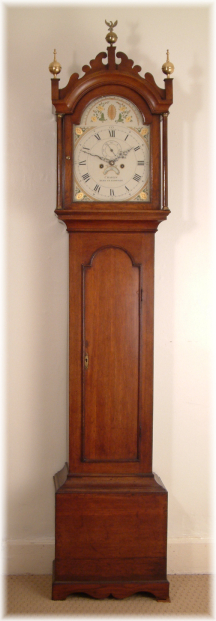 |
Thomas Chaplin and William Chaplin partnership 1776-1799 The Chaplin brothers, William and Thomas, are recorded as coming from London to work in Bury St Edmunds in 1776, setting up as clockmakers, jewellers and silversmiths. They opened another shop in Lavenham in 1777 and branched out into groceries. William was originally apprenticed to George Boston Maynard of Long Melford in 1766, for a fee of 44. Thomas was apprenticed in 1770 to "Marvelous Froud of Holbrook, taylor" for a fee of 6.0.0., but possibly this was a different Thomas Chaplin. When William died in 1799, Thomas continued the business, possibly until his death aged 81 in 1827, having taken Thomas Fuller as a partner circa 1815. William Chaplin was buried at Acton, near Sudbury, on December 28th 1799. It is possible that Thomas retired in 1815 allowing Thomas Fuller to continue the business in his name. A notice in the Ipswich Journal dated the 6th of April, 1776 reads: Messrs. Chaplins, Watch and Clockmakers, Silversmiths and Jewellers, from London, having opened a shop at the Upper end of the Cook-row, Bury St Edmunds.. All sorts of spring and musical clocks, repeating and horizontal watches as cheap as in London. Wm Chaplin. Tho. Chaplin. N.b. Turret and Church clocks made, mended, and kept in order by the year'. Other advertisements are known for them which are both flamboyant and descriptive showing that not only were they in the clock and watch trade but also sold groceries, teas, wines, spirits and coal! The shop was in Cook Row, in Bury St Edmunds, which is now known as Abbeygate Street, the name having changed in 1792. The first clock shown here is from the stock of clock dealer Leigh Extence.
|
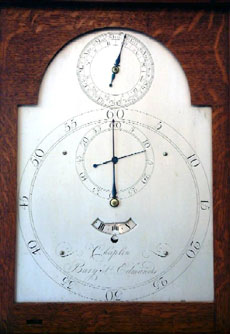 |
The Gershom-Parkington collection includes an unusual regulator Longcase clock (c 1780), by the Chaplins as well as a Tavern wall clock made circa 1795. The second clock is the regulator from the Clock Collection of Gershom Parkington. This is a normal longcase timepiece with a reversed recoil escape wheel used with dead beat pallets. Another singular feature is the annual calendar in the arch which is continuously geared into the movement by a worm wheel visible through the left hand hood window. The annual calendar is supplemented by an additional ring with signs of the Zodiac. The recently made oak case is veneered in yew. This is a domestic regulator which may have been the Chaplins shop clock. The unusual calendar exhibited the clever craftsmanship of the brothers to their customers, and dates from about 1780. William Chaplin died in 1799 and was buried in Acton, and Thomas died in 1827. Both brothers were buried in Acton, near Sudbury. Thomas Chaplin continued as a sole trader and is recorded here under the 19th Century list, on the next page of this account of local clockmakers.
|
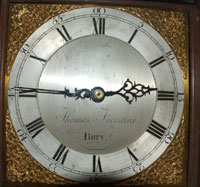 |
Thomas Freestone, Bury St Edmunds, 1769-1780 At the sale of the contents of Rollesby Hall , on the instructions of the executors of Sir Patrick and Lady Benn deceased on 22nd March 1995 , Lot 686 was described as " Provincial oak cased Grandfather Clock with square brass spandrel dial with 30 hour movement, the face inscribed "Thomas Freestone, Bury", circa 1768-1778". A photograph of the clock face was included in the catalogue. This clock currently resides in Thurston. The 1979 Catalogue of the Gershom Parkington Collection included the movement only of a 30 hour Longcase clock by Thomas Freestone, dated c1765. It has a brass dial with female head, and scroll spandrel with two hands. Freestone worked for a time in Bury St Edmunds, but was the grandson of the eminent Ipswich Clockmaker, Thomas Moore. In 1770, he took on his brother, Edward Freestone, as an apprentice, for a fee of 40. His grandfather, Thomas Moore, had left Edward this sum in his will for this purpose. The Ipswich Journal of 10th June, 1769 has Thomas advertising that "Thomas Freestone, Watch and Clockmaker, from London, (grandson of the late Mr Thomas Moore of Ipswich) has taken a shop in the Butter Market, Bury St Edmunds." The London Gazette of 28th July 1778, recorded the bankruptcy of "Thomas Freestone, watchmaker, formerly of Ipswich, lately of Bury." On 5th August, 1780, Freestone advertised in the Ipswich Journal, that "Thomas Freestone, Watch and Clockmaker, Eastgate Street, Bury St Edmunds, informs owners of postchaises he is authorised to sell brass plates with the owners name and place of abode engraved thereon, according to the Act of Parliament."
William Rust, Bury St Edmunds, 1769
Rust is known only from this advertisement in the Ipswich Journal for 28th January, 1769: Thomas Watts of Hadleigh had himself apparently taken over this shop from Mark Hawkins junior, in 1765, three years before his death in October, 1768.
John Roberts, Bury St Edmunds, 1777-1791 Roberts is first known from an advertisement in the Ipswich Journal for 19th April, 1777. He announced: "John Roberts, watch and Musical clockmaker in the Hatter Street, St Edmunds Bury extends thanks for repeated favours. Apprentice and Journeyman wanted." This appeal was repeated on 2nd August. Nothing further is known until an entry in the Universal British Directory of 1791.
|
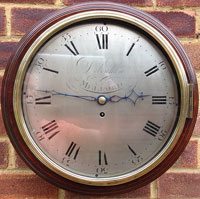 |
Robert Strange Debenham, Long Melford, 1778-1795 This shows a late 18th century verge escapement fusee wall clock by Robert Debenham from Melford (Long Melford), Suffolk. Cove Clocks of Farnham had it for sale in March 2016, described as a 12" silvered and engraved brass dial with blued steel diamond pattern hands, protected by a concave glazed brass bezel. "A" plate verge escapement line fusee movement, separated by knopped pillars. Mahogany case, pegged back box, shaped top and bottom, with pendulum access side and bottom doors. Robert Strange Debenham was working in Long Melford, opposite the Bull Inn, 1778-95. This clock is thought to date Circa 1790, and is on sale for 4500.00.
Henry Browning, Bury St Edmunds, 1783 According to an advertisement in the Ipswich Journal for 8th November 1783, Henry Browning, Watchmaker, had a shop in the Cook Row in Bury St Edmunds. A long case clock and a watch are known with his name on.
Robert Rogers, Bury St Edmunds, 1784 Bayley's Directory of 1784 lists Robert Rogers as a Silversmith and Toyman in the Cook-Row.
John Tilbrook, Bury St Edmunds, b c1750 died 1810 John Tilbrook worked in Bury St Edmunds in the late 18th century as a Jeweller and Silversmith. His death was reported on 11th July 1810, in the Bury and Norwich Post, as follows: "On Saturday last, after a long illness, aged 60, Mr John Tilbrook, an eminent silversmith and jeweller of Hatter-street in this town." The Gershom Parkington Collection has a Chatelaine watch in a silver pair-case by him, hallmarked 1780/81. This is signed "Jno. Tillbrooke, Bury, No 240." The collection includes another in a brass gilt case of a similar date, signed "J. N. Tilbrooke, Bury, No. 819". Both Baillie and Britten recorded a watch by him in the Dennison collection, dated to 1785. When he died, in 1810, he was succeeded by his son, Robert Tilbrook, who carried on the business in Hatter Street until 31st March, 1821, when a notice to his creditors and debtors was published in the Ipswich Journal.
Mary Lumley, Bury St Edmunds, (b1724-d1800) George Lumley's widow, Mary, carried on the business after his death. She advertised in the Ipswich Journal for 25th September, 1784, "Mary Lumley, widow of the late Mr Geo. Lumley, Clock and Watchmaker, returns thanks to the friends of her late husband.....She intends carrying on the business as usual." In July 1785 John Gudgeon, (see C19 watchmakers), married Mary Lumley, but this Mary is believed to be the daughter of Mrs Mary Lumley. The marriage lines described Mary as "single", rather than as "widow", if it were Mary senior. At some point in the same year, 1785, Mrs Mary Lumley the elder, entered into business partnership with John Gudgeon. It is likely that Gudgeon moved into the Lumley shop at the Cook Row address now known as 14 Abbeygate Street, (today the premises of Thurlow Champness), to carry on the business. When Mrs Lumley died in 1800, she was described in the local press as "an eminent watchmaker." John Gudgeon now carried on alone in the same premises. The Gershom Parkington collection has one watch which could be attributed to Mary Lumley. In any case it is likely that it was not sold until she had taken over the business. This watch, from about 1785 has letters instead of numbers on the dial. These read RICHARd PICKANn, possibly the name of the purchaser. Because his name contained more than twelve letters, the final letters of each name were reduced to lower case. It is a treble cased gilt metal watch, signed, "Lumley, Bury, No 376". The style is more modern than the Lumley watch of 1780, described above.
Bilby Dorling, Bury, 1759-1796 In 1750, Bilby Dorling was apprenticed to Mark Hawkins of Bury St Edmunds, for a fee of 10. In 1759 Bilby Dorling was advertising as a clock and watch maker in Cook Row at Bury. His shop was known by the sign of the Spring Clock. In 1796 he entered into partnership with Joseph Sinkinson. After 1792, Cook Row was called Abbeygate Street. One Long Case clock is known from Dorling.
William Shaw of Botesdale, 1759-1790 There are several William Shaws who were clockmakers in Diss and Gislingham, as well as a George Shaw of Botesdale who married in 1790. The Ipswich Journal of 7th June, 1760 advertised as follows: "William Shaw, Clock and Watchmaker in Botesdale, makes, mends and sells, all sorts of clocks and watches. He also begs leave to inform the Publick that he has taken a shop in DISS (on the decease of Mr Shuckforth), where he attends Tuesdays and Fridays." A lantern clock is known from William Shaw, signed,"Willm. Shaw Botesdale fecit". This clock has an alarm, with an arched dial.
John Clark c1790 John Clark of Bury St Edmunds is also represented in the Gershom Parkington collection by a watch movement only, dated to around 1790. It is signed, "John Clark, Bury, No 73." There is also a John Clark recorded at Sudbury from 1782 -1810, and it is possible that this was the same man.
John Collins of Wattisfield, b1750-d1829 John Collins signed all his clocks as Wattisfield, but he may have lived in Rickinghall Inferior parish. He made many Long Case clocks with square brass dials, and 30 hour movements. He favoured plain oak cases, low enough to fit under low country ceilings. He may have been succeeded by Spalding Collins at Wattisfield, (Directories 1846-1864), and Thomas Collins at Botesdale (Directories 1823-1864).
|
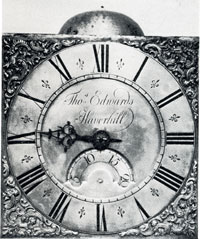 |
Thomas Edwards of Haverhill, second half of 18th century Thomas Edwards was described by Haggar and Miller as a typical country clock maker. They cite the example of a long case clock with a single hand, and a 30 hour movement. Described by Haggar and Millar as "a typical 'Suffolk' clock in the style of country makers. The square brass dial illustrated here, taken from Haggar and Miller, is of this 30 hour movement, showing the later pattern of calendar aperture. It is dated to about 1775. The Long Case which contained it was described as having rococo spandrels.
Charles Spicer of Haverhill, pre-1768-1776 The Ipswich Journal for 10th January, 1768 carried the following advertsiement: "Lost Watch, the Maker's name 'Charles Spicer, Haverhill, Suffolk', to be taken to Mr Corbett, watchmaker in Hadleigh." Aged 30 and a widower, he remarried to Elizabeth Moody of Ridgewell on 1st June, 1776.
John Spendlove, (or Spendlow) of Thetford, b1704 d1788 John Spendlove I, was the son of William Spendlove of Metfield, who built the Cratfield church turret clock in 1709. William was a blacksmith who gradually included large clocks in his trade. William's eldest son was Henry Spendlove, 1697-c1756, who remained in business with his father at Metfield producing lantern and longcase clocks. John Spendlove I was born in Metfield in 1704. He moved from Metfield to Hingham some time around 1745, and moved to Thetford in about 1764. He left at least two Long Case clocks signed from both of these locations. He was the father of John Spendlove II and James Spendlove. The Spendlove family details come from Trevor Spindler's article in Antiquarian Horology of December, 2010, who kindly emailed me with details in December, 2016. I have concentrated only upon those Spendloves in West Suffolk.
|
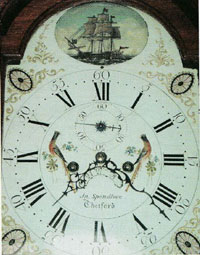 |
John Spendlove II, (or Spendlow) of Thetford, b1738 d1817 John Spendlove II was the oldest son of John Spendlove I, a clock maker at Metfield, who moved to Thetford in about 1764.
John Spendlove II, was baptised at Metfield on 21st November, 1738, but would have moved to Thetford with his father in about 1764. John Spendlove II became a prominent citizen of Thetford, and produced many clocks there. He was elected a Commoner to Thetford Council in 1772, a post he held for 45 years until his death. In 1801 he was on the Grand Jury, and was also apponted Jailkeeper. The Bury Post called him "a stirling maker of high class clocks" in its obituary of him. The Gershom Parkington Collection has one of his silver watches, with a verge escapement from c1790. Trevor Spindler lists 11 longcase clocks attributed to John Spendlove of Thetford, and one labelled John Spendlove of Brandon.
James Spendlove, of Brandon, b 1753, d1831 in Brandon James Spendlove was born at Hingham in Norfolk, and baptised on 29th December, 1753. His father was also a Clockmaker, called John Spendlove I, and he was the brother of John Spendlove II. James Spendlove was the younger brother of John Spendlove II, and they may have helped each other out as both men have at least one clock labelled from the town where the other worked. Bayley's British Directory of 1784 recorded him as a Watch and Clock maker of Brandon. As did the 1791 Universal British Directory. His wife died in 1817. Trevor Spindler records a longcase case labelled James Spendlove of Brandon and one lantern clock of his recorded from Thetford.
John Simpson Spendlove, of Thetford, b 1791, d1852 in Thetford John Simpson Spendlove was the son of John Spendlove II, with whom he continued in business. He never married and lived with his sister Hannah Spendlove. He carried on his father's business after 1817, and after his own demise in 1852, Hannah continued to run the business until her own death in 1864. Two silver watches are known by John Simpson Spendlove.
William Sleightholme of Ixworth, 1787 Sleightholme is known mainly from his marriage license, dated 8th June, 1787, where he was described as a watchmaker. He married Mary Robinson of Ixworth. There is one watch paper bearing the name "Sleightholme, watchmaker", in the Museum of the History of Science in Oxford.
|
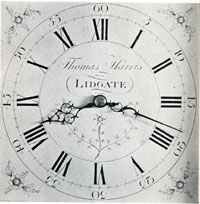 |
Thomas Harris of Lidgate, c1792- c1796 In their Supplement to the Clockmakers of Suffolk, Haggar and Miller declared that it was very difficult to sort out the various members of the Harris family, as they often shared christian names, and were spread over three counties. The Thomas Harris of Lidgate whose clock is shown here would seem to have been baptised at Chippenham on 6th May, 1769. On 22nd December, 1791, he married Jane Fincham at the same place. A daughter, Jane, was baptised at Lidgate on 4th November, 1792, but John and Eliza were baptised at Chippenham in 1796 and 1806. Thus Thomas was likely to have worked at Lidgate only between 1792 and 1796.
The illustration here comes from Haggar and Miller, and shows the dial of a 30 hour Long Case clock in elm. It is dated to c. 1780, and and is described as an attractive dial of brass, silvered and engraved. It is signed, "Thomas Harris Lidgate". If the Supplement has correctly identified him, then the dating is more likely to be c 1792-6. |
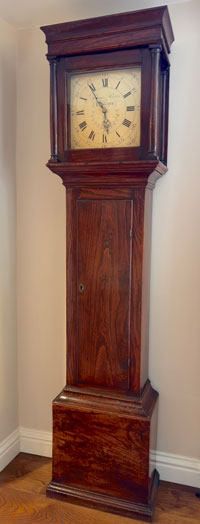 |
Years after writing the above entry, in November, 2024, I received several emails from Michael Wells, who lives in Lidgate. "The news is that I am now the keeper of the Lidgate clock in the photograph. As an avid clock repairer myself, ever since I learned this I have been on the look out for one of Harris' clocks. To make matters tougher, there is another rather prolific clockmaker by the same name. He lived and worked in Deddington (Oxfordshire) a few decades earlier than our local Suffolk man. Although very good too, his clocks are not the ones of interest. In practice, this has made locating a clock by Thomas Harris of Lidgate extremely challenging, since almost any match found in various national auction listings is for the wrong person's clocks. Occasionally, I looked at the photo in the book and wondered where the clock might be, how many others there are like it, and how I could go about uncovering their whereabouts. I had more or less given up any real hope of finding a Lidgate clock, and at best only finding more of the Deddington examples year after year. A sort of horological dead end, deeply frustrating given the sure knowledge that the Lidgate clocks exist. In late October 2024 an alert about the keyword of "Thomas Harris clock" came through on my alerts. It was in an auction in Essex. I was startled when they confirmed the good news - it was in fact a Lidgate clock. The silvered brass dial is engraved, "Thomas Harris, Lidgate". Imagine my even greater surprise to realise it was almost certainly the very same dial as featured in the Haggar and Millar book, including various distinctive blemishes that identify it as the same clock. By mid-November (2024) the clock was on its way back home to its birthplace in our village. It is beautiful and fully functional, in good working order, but has been misassembled at some point preventing it striking the bell correctly - it's in need of a service, which I will undertake soon. As longcase clocks go, it's quite simple. It is a rustic 30-hour clock in a hardwood case. Every day, the weights are lifted to give it power for another day, and the bell strikes the hours on the hour. It would look at home in any of the old cottages of Lidgate. I am sure you can imagine my pride in having it back in our village where it started, and I will ensure it stays here. I wonder if there might be a way to determine where Thomas Harris, his wife Jane and their children lived in the village? Michael Wells November 2024" Haggar and Miller also noted that an oak Long Case clock was sold by Apthorpe's of Diss in 1976, signed, "Thomas Harris, Lidgate". This may have been the same clock. They also noted that this dating makes it unlikely that the following clock was made by him, as lantern clocks were out of fashion by this time. Thus another man called Harris probably left the large 'sheeps head' type lantern clock, with dolphin frets sometimes attributed to him. Also a brass dial 30 hour Long Case clock signed "Harris, Lidgate".
Now click here to move on to The local 19th Century Makers
|
|
"Time Measurement Instruments- catalogue of the John Gershom Parkington Memorial Collection" 3rd edition of 1979 Information prepared by David Addy, 27th April 2006
|
| Go to Clocks Homepage | Last updated 4th April, 2018 and 18th November, 2024 | Go to Home Page |